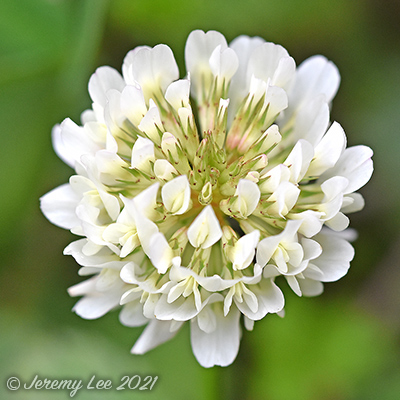
 |
|
Scientific Classifications explained » Amphibians » Ants » Aphids » Bees » Beetles » Birds » Bugs » Butterflies » Caterpillars » Damselflies » Dragonflies » Earwigs » Flies » Frog/Leafhoppers » Fungi » Galls » Grasshoppers » Harvestmen » Hoverflies » Lacewings » Ladybirds » Leaf Mines » Lichens » Mammals » Millipedes » Mosses » Moths » Sawflies » Slugs » Snails » Spiders » Trees » Wasps » Wild Flowers » Woodlice |
UK Nature > Wild Flowers > White Wild Flowers > Trifolium repens

Scientific Name: Trifolium repens Common Name: White Clover Trifolium repens, more commonly known as White Clover, is a herbaceous, mat-forming perennial, 5-20cm tall, with white or cream to pinkish-tinged flowers. It grows among turf grass, crops, and in a large number of other landscapes. It is also found in a limited range of different field type environments. White clover can tolerate close mowing, and can grow on many different types and pHs of soil, but prefers clay. It is considered to be a beneficial component of natural or organic lawn care due to its ability to fix nitrogen and out-compete lawn weeds. Natural nitrogen fixing reduces leaching from the soil and can reduce the incidence of some lawn diseases that are enhanced by the availability of synthetic fertilizer. |
|

https://www.uknature.co.uk is a website dedicated to showing the immense diversity of UK nature and wildlife. Our vast range of habitats, from lowland arable to snow covered mountains, from storm-ravaged coastlines to peaceful inland freshwater lakes and rivers, from dry, sandy heaths to deciduous and coniferous forests, all these habitats contribute to the abundance of UK nature. We have wild birds in huge numbers either residing or visiting our shores (597 recorded species as at July 2013) and we must also not forget the humble back garden with its grass lawns, flower beds filled with nectar rich flowers, shrubs and trees, all designed to attract huge numbers of insects such as bees, moths, butterflies and hoverflies; and finally the small ponds which provide safe havens for frogs, toads, newts and even slow worms and grass snakes. www.uknature.co.uk is the showcase for my personal passion, photographing uknature in all its glory. I sincerely hope you all enjoy the fruits of my labours. This site and all images contained therein is © Jeremy Lee 2004 - 2021. All Rights Reserved. Site design by Jeremy Lee. Site development & IT Support by Stuart Lee. |